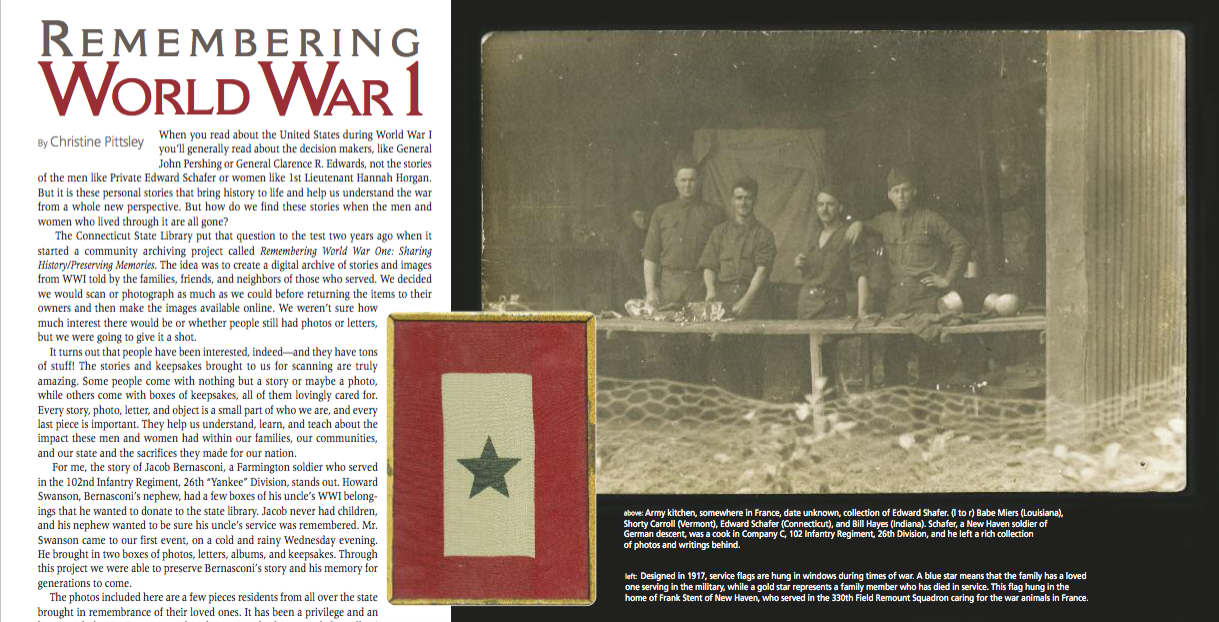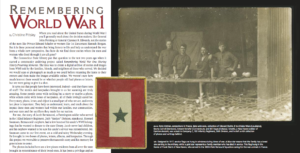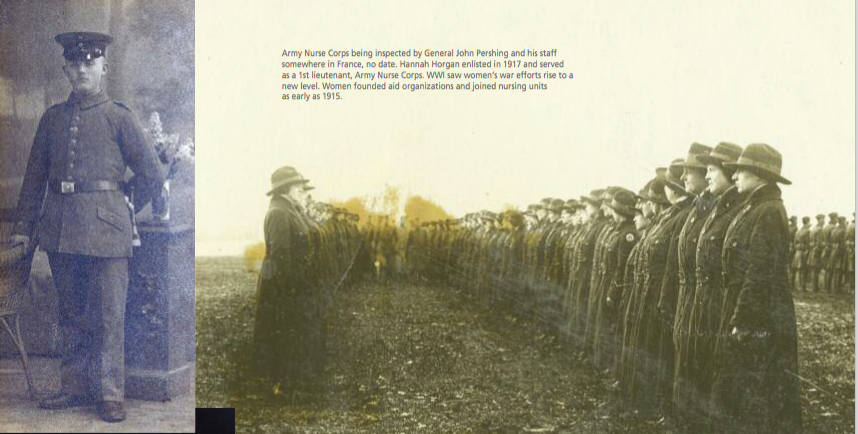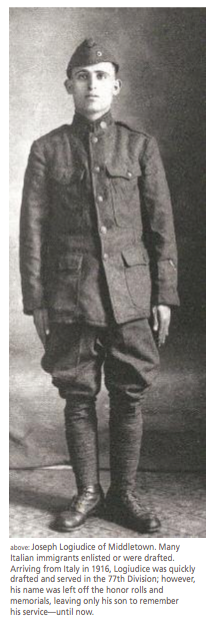By Christine Pittsley
(c) Connecticut Explored, Spring 2017
When you read about the United States during World War I you’ll generally read about the decision makers, like General John Pershing or General Clarence R. Edwards, not the stories of the men like Private Edward Schafer or women like 1st Lieutenant Hannah Horgan. But it is these personal stories that bring history to life and help us understand the war from a whole new perspective. But how do we find these stories when the men and women who lived through it are all gone?
The Connecticut State Library put that question to the test two years ago when it started a community archiving project called Remembering World War One: Sharing History/Preserving Memories. The idea was to create a digital archive of stories and images from WWI told by the families, friends, and neighbors of those who served. We decided we would scan or photograph as much as we could before returning the items to their owners and then make the images available online. We weren’t sure how much interest there would be or whether people still had photos or letters, but we were going to give it a shot.
It turns out that people have been interested, indeed—and they have tons of stuff! The stories and keepsakes brought to us for scanning are truly amazing. Some people come with nothing but a story or maybe a photo, while others come with boxes of keepsakes, all of it lovingly cared for. Every story, photo, letter, and object is a small part of who we are, and every last piece is important. They help us to understand, learn, and teach about the impact that these men and women had within our families, our communities, and our state and the sacrifices they made for our nation.
For me, the story of Jacob Bernasconi, a Farmington soldier who served in the 102nd Infantry Regiment, 26th “Yankee” Division, stands out. Howard Swanson, Bernasconi’s nephew, had a few boxes of his uncle’s WWI belongings that he wanted to donate to the state library. Jacob never had children, but his nephew wanted to be sure his uncle’s service was remembered. Mr. Swanson came to our first event, on a cold and rainy Wednesday evening. He brought in two boxes of photos, letters, albums, and keepsakes. Through this project we were able to preserve Bernasconi’s story and his memory for generations to come.
The photos included here are a few pieces from residents all over the state brought in remembrance of their loved ones. It has been a privilege and an honor to help Mr. Swanson and each person who has attended a collection event to remember the sacrifices of those who served during the war to end all wars.
(large image) Army kitchen, somewhere in France, date unknown, collection of Edward Shafer. (l to r) Babe Miers (Louisiana), Shorty Carroll (Vermont), Edward Schafer (Connecticut), and Bill Hayes (Indiana). Schafer, a New Haven soldier of German descent, was a cook in Company C, 102 Infantry Regiment, 26th Division, and he left a rich collection of photos and writings behind.
(inset, above) Designed in 1917, service flags are hung in windows during times of war. A blue star means that the family had a loved one serving in the military, while a gold star represents a family member who has died in service. This flag hung in the home of Frank Stent of New Haven, who served in the 330th Field Remount Squadron caring for the war animals in France.
(right) Jacob Bernasconi of Farmington was wounded in action at Château Thierry in July 1918. In 1935, after he took a fall, doctors operated and discovered this piece of shrapnel near his pelvic bone. Bernasconi saved the shrapnel and the gauze it was wrapped in as remembrances of his sacrifice.
(below left) In the decades after the war, veterans’ organizations such as Hartford’s German Austrian War Veterans Post No. 18 sprang up across the country. Ferdinand Weimann, a member of that group, was born in Plock, Russia and was drafted into a Pioneer Battalion in the German army during the war. A shoemaker by trade, he dug under French trenches in an effort to blow them up. After the war Weimann came to Hartford and worked for the Taylor & Fenn Company in Windsor.
(above, right) Army Nurse Corps being inspected by General John Pershing and his staff somewhere in France, no date. Hannah Horgan enlisted in 1917 and served as a 1st lieutenant, Army Nurse Corps. WWI saw women’s efforts rise to a new level. Women founded aid organizations and joined nursing units as early as 1915.
(right) Joseph Logiudice of Middletown. Many Italian immigrants enlisted or were drafted. Arriving from Italy in 1916, Logiudice was quickly drafted and served in the 77th Division; however, his name was left off the honor rolls and memorials, leaving only his son to remember his service—until now.
(below, right middle) Stained-glass triptych by Walker O. Nettleton. Nettleton, a chemical warfare officer from Guilford, collected pieces of ancient stained glass from the damaged Soissons Cathedral dating from the early 13th century and assembled this triptych, adding the antique hand-blown cobalt-blue pieces.
(below right) Robert Bonner Remington, of Hamden. Bonner was one of 12 children. He and two brothers served in the war. Like many other Connecticut men, he fought in the Battle of Seicheprey on April 20, 1918. Wounded by a bayonet, he died in a field hospital on May 1, just 17 days before his 19th birthday.
(below left) German Private Emil Hoffman, 1918, photo: Merritt Learned. Hoffman was captured by the American Expeditionary Forces during the Battle of St. Mihiel on September 14, 1918. His captor, Merritt Learned of Meriden, kept in touch with Hoffman after the war. In a letter to Learned in the 1930s, Hoffman mentioned working for a “gentleman farmer” and expressed gratitude to “our fuhrer Adolf Hitler. He has given us all jobs.” This sentiment was prevalent after the war as Germany suffered crippling economic and social upheavals.
(above, left middle) Ashtray made by Walter C. Consic of Moodus of shell casings, safety razor, and pack holder. One of the most popular kinds of souvenir for soldiers to bring home was called trench art. The pack holder at the top is engraved with Consic’s name on one side and a caduceus (symbol of medicine) on the other.
Christine Pittsley is project manager for Remembering World War One: Sharing History/Preserving Memories.
Explore!
Visit the Remembering World War One: Sharing History/Preserving Memories online database at ctinworldwar1.org.
Coming Fall 2017: Looking Back, Looking Forward: Connecticut’s Role in the Great War, Connecticut State Library, 231 Capitol Avenue, Hartford. ctstatelibrary.org






